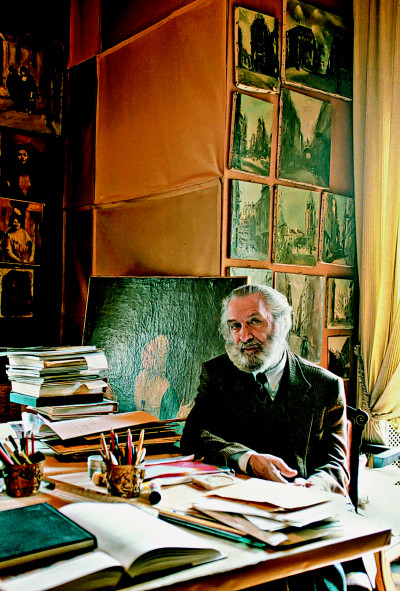Lorenzo Mongiardino (Lorenzo Mongiardino)

In 1936 Renzo Mongiardino moved from Genoa to Milan to study architecture; in 1942 he graduated from the Politecnico di Milano, together with Giò Ponti. Beginning in 1944, Mongiardino collaborated Domus magazine, writing many articles. During this period he also began his multifaceted career, focusing primarily on the creation of residential and theatre environments. In the early fifties Mongiardino began to establish himself as an architect, working from his home and studio in central Milan, on the elegant Via Bianca Maria. Mongiardino was responsible for creating some of the most important and enchanting houses of the second half of twentieth century, created for an international and prestigious clientele of cultured collectors and entrepreneurs including Baron Hans Heinrich Thyssen-Bornemisza, Aristotle Onassis, Gianni Agnelli and Marella Agnelli, Lee Radziwill and Stanisław Albrecht Radziwiłł, Gianni Versace, Edmond Safra and Lily Safra, Princess Firyal of Jordan, Valentino Garavani, the Rothschild family and the Hearst family. Also starting in the late fifties Mongiardino began his career as “production designer” in Theatre and Cinema together with Franco Zeffirelli, Peter Hall, Giancarlo Menotti and Raymond Rouleau. In 1993 Rizzoli published “Roomscapes”, a lessons-learned monograph about Mongiardino in which revealed some of his standards of interior design, without forgetting his irreplaceable craftsmen and assistants able to transform his aesthetic dreams into reality; united to his “elective affinity that arrives after years of cooperation and in continuous exercise of affectionate understanding”. After the arson of theatre “La Fenice” in 1996, Gae Aulenti assigned Mongiardino the project for the interior theatre refurbishment, a project which he was not able to complete. Mongiardino died in Milan on 16 January 1998.
The years of Mongiardino’s debut are those of the Modern Movement, but he resisted this new wave, fearing its effects, and perceiving an intrinsic lack of feeling. Instinct took him elsewhere, to seek the harmony of the antique that draws on and re-invents itself in a completely new way. The private nature of his projects and their nature, in the sense that they are an ends unto themselves, and will most likely not survive beyond the lives of their owners, brings with it the risk that Mongiardino’s name may not correspond to anything definite, but true only as evocation of the rich and famous world. There are in fact several public works of Mongiardino, including two buildings built in Milan (in Via Donizetti and in via Borgonuovo), the restoration of several important hotels (the lobby bar at The Carlyle in New York, The Hotel Kulm in St. Moritz, The Plaza in Rome), as well as the restaurant (“Da Giacomo” in Milan) and several shops, including Sabbadini Jewelers on Milan’s Via Montenapoleone. But these works are the exception that the primary focus of Mongiardino’s research, which was addressed almost exclusively to the preparation of domestic spaces, through a careful combination of the search for harmonious proportions and a love for the meticulous execution of every detail.
Before Mongiardino, houses were built in a particular historical style. Mongiardino revolutionized this methodology. He writes: “The houses are furnished, are created considering the structure, the skeleton, the intrinsic beauty, when there is. We believe we can invent a new house, a universal model that could be replicated identically in Naples as in Stockholm. But the house is not an invention, it is always the same shelter that man needs because he is tired, because he’s hungry, because he has to sleep. Older houses were built on the extent of these practical needs, they expressed the authenticity of the goods and used the same limits imposed by available materials and technologies called for the pursuit of beauty in function. Skilled creator of spectacular spaces, he has been able to juxtapose ordinary objects and antiques, in a masterly game of fabrics or painted, and sculptured panels and a range of trompe l’oeil, whereby he obtained masterpieces with poor materials. Fundamental in his work, however, is the determination of space, the search for a balance of proportions that must precede the decoration. Precisely this is his book “Roomscapes”. Only later Mongiardino inserted, with the sensitivity set designer, fakes and real objects presented without any hierarchy of values in a setting in which each subject was taking its natural space.
Born
- May, 12, 1916
- Genoa, Italy
Died
- January, 16, 1998
- Milan, Italy
Cause of Death
- pneumonia

